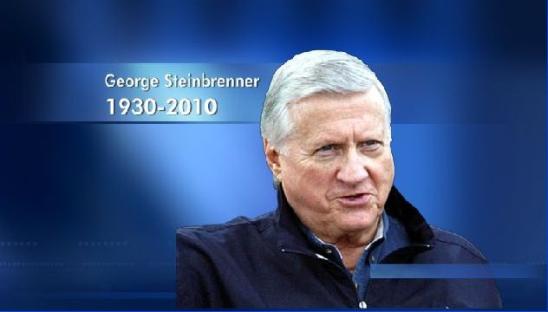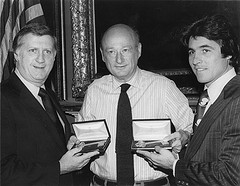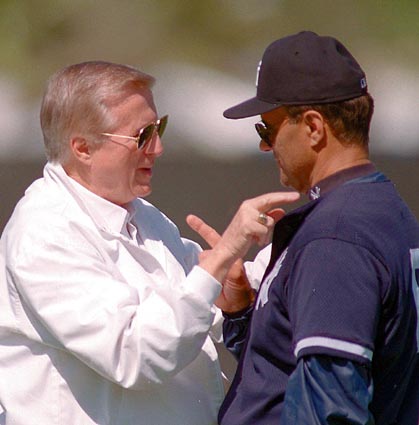‘Everyone knew he was destined to be an important figure in the history of the City. And so he is.’
Ed Koch on George SteinbrennerMy comments on the death of George Steinbrenner:
I am not a big sports fan. George Steinbrenner meant little or nothing to me before I was elected Mayor New York City in 1977. Then, suddenly, he meant a lot.
When the Yankees won the World Series in 1978, the City went crazy with joy. Remember, at that time New York was in a state of depression because of the City's economic decline. We were on the edge of bankruptcy. Indeed, Mayor Abe Beame had actually prepared bankruptcy papers for New York City before the Democratic primary, which I won. But he had not yet filed those papers by the time I took over.
I knew that bankruptcy was not an option if we were to avoid becoming another Detroit. So when the Yankees won the Series in '78, it was a huge boost to our morale. I announced that I would authorize a tickertape parade to celebrate. The New York Times, I recall, published an editorial urging me not to, saying it would be a needless expenditure. I knew, however, that New Yorkers needed a lift. I responded to The Times with the comment, "New York Times, you have your head screwed on wrong!" The parade was held, with a ceremony at City Hall. It had a wonderful, energizing effect on the people of this great city. In other words, George Steinbrenner's success in bringing a winning tradition back to Yankee Stadium had an important impact on New York City's return to full economic health.
George Steinbrenner and Yankees
shortstop Bucky Dent receive keys to
the city from Mayor Ed Koch
after the Yankees’ 1978 World Series
victory.The Yankees' World Series trophy was placed on display in the City Hall Rotunda for 30 days. Thousands of people streamed in to see it. Years later, I was asked by Senator Chuck Robb of Virginia to take a delegation down to Nicaragua to monitor the Esquipulas II Accords, settling the civil wars taking place in Central America. I knew that Nicaragua's dictator, Daniel Ortega, was a Yankee fan, so I asked George Steinbrenner if he would give me six Yankee uniforms to give to Ortega. He did. I attended a big rally in Nicaragua where the plaza was packed with tens of thousands of Ortega's bully boys, who looked like the storm troopers of Hitler's Nazi Germany. Ortega was giving a speech denouncing the United States. As I passed in front of him, he was yelling, "Yankees will die either here or there."
Then, seeing me, he said, "Except this Yankee, Ed Koch; he is as safe here as he would be on 42nd Street." The crowd roared approvingly. The next night when I met Ortega and gave him the six Yankee uniforms, Ortega smiled and said, "I love the Yankees." I said, "You didn't last night," and he laughed.
George Steinbrenner was a winner who knew how to negotiate. He was constantly threatening to take the Yanks out of the Bronx and away from New York City. In the late '80s, we wanted to extend his lease on Yankee Stadium, and we ultimately got him to the point where he agreed. We agreed to all the terms, which included our getting 10 percent of the $50 million that the Yankees were then receiving for cable television rights. However, just before I left for Nicaragua, George called and said he wanted a two-week delay to select an option which had been offered to him by the City and which did not affect the overall contract. I, of course, said yes. Several weeks later, he called again and told me he was declining to sign the extension. The reason, we learned, was that he had gotten a deal increasing his cable television rights to $500 million, and he didn't want the City to get the 10 percent. We had shaken hands on the deal, but he was a tough—and sometimes ruthless—negotiator. For George, business was business.
George Steinbrenner will always be remembered and associated with the great New York Yankees. Even in the early days of his extraordinary ownership of the Yanks, everyone knew he was destined to be an important figure in the history of the City. And so he is.
***
Steinbrenner Was a Bully
‘Steinbrenner was always in control, always powerful, and never satisfied. It is there where the ultimate justice lies. All those World Series rings meant nothing.’
By Roger I. Abrams
Sports Law AuthorityThose who have offered their assessments of George Steinbrenner upon his passing have focused on his insatiable drive for victory. This is lauded as a truly American passion. Vince Lombardi, the legendary coach of the Green Bay Packers, another American original, opined: "If winning isn't everything, why do they keep score?" Steinbrenner's philosophy is solidly based on Lombardi's edict: "Show me a good loser, and I'll show you a loser."?There is no question about the impact Steinbrenner had on the game of baseball. He was every other owner's nightmare — a rival who was willing to spend what it took to secure the best players money could buy. If in the process he bought some lemons, there was more than enough good fruit left to secure a winning club.
He was without question a great supporter of the interests of the Major League Baseball Players Association, although he never would have admitted it. The Union fought for years for free agency—winning eventually before a courageous labor arbitrator—but it was Steinbrenner who converted the players' victory into dollars. No one forced owners to spend their money. Unlike football, for example, there are no team salary floors in baseball and a club can get through by simply paying the minimum salary to 25 players. No club actually does that, but some come close.
Steinbrenner was ready on the other end of the spectrum to make free agency and the free market a reality for ballplayers. Once again, no one forced him to pay eight figure salaries — no one except George Steinbrenner. The New York Yankees club had the benefit of the best of the large markets, and thus the club could carry the largest payroll.
There was one prevailing characteristic of George Steinbrenner that should be remembered, however, and that was not that he spent so much money on ballplayers. Steinbrenner throughout his career was a bully.
You need not be wealthy to be a bully or especially mean, although that certainly helps. You do need to have a positive, if arrogant, self image and be willing to visit upon others the exercise of power at your discretion. You need to have an abundance of internal aggression and a hostile attribunal bias. Bullies believe others are out to get them, a paranoia of sorts. A bully acts first to revenge perceived slights that do not exist.
It is comforting to learn from studies that bullies are sad people, but that provides no solace to their victims. Steinbrenner's victims, and there were many, felt powerless in the face of The Boss. Although otherwise accomplished individuals, Steinbrenner's victims were submissive and nonassertive.
Yogi Berra, George Steinbrenner and Billy Martin celebrate the Yankees’ 1977 World Series triumphThe Billy Martin-George Steinbrenner dance that lasted from 1975 until 1988 is the most obvious example. Martin was a talented player and manager and Steinbrenner fired him five times—and rehired him each time. Martin was preparing to take the helm of the pinstripes for a sixth time in 1990 at the time of his death. Even though their relationship turned comical after a while, it was perverted. Steinbrenner was the emotional aggressor and Martin the foil. Steinbrenner was always ready to explode. Someday we will learn that bullies simply have a disruption in their neurotransmitter systems. Their serotonin, norepinephrine, and dopamine pathways are clogged. Whatever the underlying chemical reason, Steinbrenner exercised his power with abandon.
Steinbrenner was not the only bully in the public domain. Others, like Mel Gibson, have been in the news lately for bullying their victims. Every industry has CEOs who are known for their bullying tactics. Even the academic world has its bullies among its presidents and deans. Steinbrenner stood alone, however, in the public mind as the supreme oppressor.
No one but the commissioner of baseball could stand up to Steinbrenner, and even he allowed Steinbrenner back into the game after banning him for life. He ended his days as a bully long enough ago that he could be remembered fondly by many. For others, the stain of having been his victim will never end. Steinbrenner was always in control, always powerful, and never satisfied. It is there where the ultimate justice lies. All those World Series rings meant nothing.From Roger I. Abrams’ Huffington Post blog of July 19, 2010. Mr. Abrams’ Sports Law Blog (“All things legal relating to the sports world…”) is at http://sports-law.blogspot.com/2009_03_01_archive.html.
THE BLUEGRASS SPECIAL
Founder/Publisher/Editor: David McGee
Contributing Editors: Billy Altman, Laura Fissinger, Christopher Hill, Derk Richardson
Logo Design: John Mendelsohn (www.johnmendelsohn.com)
Website Design: Kieran McGee (www.kieranmcgee.com)
Staff Photographers: Audrey Harrod (Louisville, KY; www.flickr.com/audreyharrod), Alicia Zappier (New York)
E-mail: thebluegrassspecial@gmail.com
Mailing Address: David McGee, 201 W. 85 St.—5B, New York, NY 10024
Founder/Publisher/Editor: David McGee
Contributing Editors: Billy Altman, Laura Fissinger, Christopher Hill, Derk Richardson
Logo Design: John Mendelsohn (www.johnmendelsohn.com)
Website Design: Kieran McGee (www.kieranmcgee.com)
Staff Photographers: Audrey Harrod (Louisville, KY; www.flickr.com/audreyharrod), Alicia Zappier (New York)
E-mail: thebluegrassspecial@gmail.com
Mailing Address: David McGee, 201 W. 85 St.—5B, New York, NY 10024





